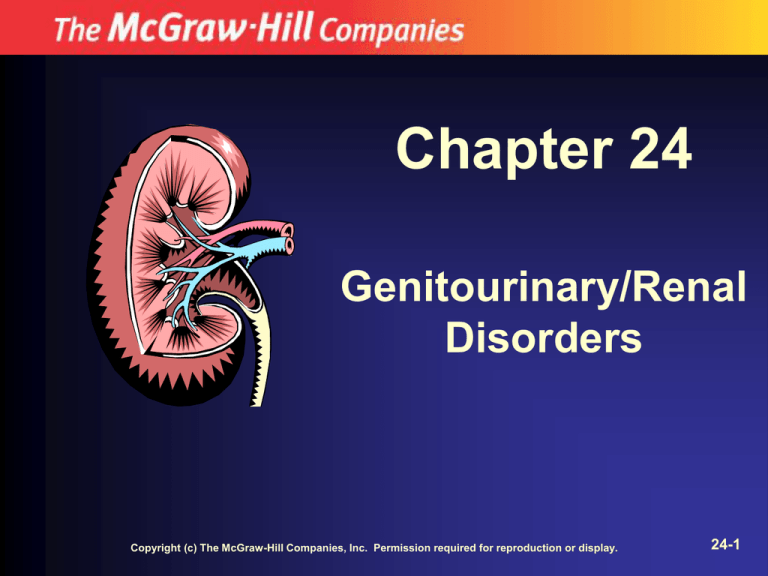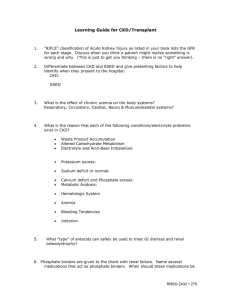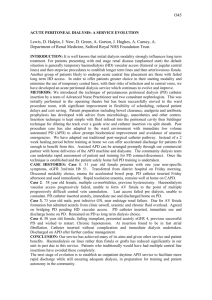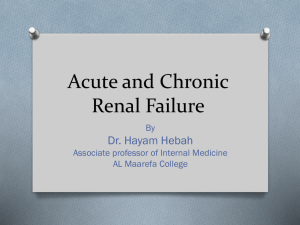Chapter 24 Genitourinary/Renal Disorders 24-1
advertisement

Chapter 24 Genitourinary/Renal Disorders Copyright (c) The McGraw-Hill Companies, Inc. Permission required for reproduction or display. 24-1 Objectives 24-2 General Anatomy • Kidneys – Retroperitoneal space – Renal artery – Renal vein – Ureter – Filter the blood – Nephrons • Function units of the kidneys 24-3 General Anatomy • Components – Kidneys – Ureters – Bladder – Urethra 24-4 Functions • The urinary system is responsible for the following functions: – Maintaining a balance of salts and other substances in the blood – Excreting waste products and foreign chemicals – Assisting in regulating arterial blood pressure – Producing a hormone that aids the formation of red blood cells 24-5 Renal Disorders 24-6 Kidney Stones • Kidney stones are also called renal calculi – A hard mass that forms from crystallization of excreted substances in the urine – Shape and size vary 24-7 Kidney Stones • Assessment findings and symptoms – Excruciating pain that is usually located in the flank, radiating to the groin – Nausea, vomiting, and sweating common – Restlessness – Hematuria – Dysuria 24-8 Urinary Tract Infection • A urinary tract infection (UTI) is an infection that affects any part of the urinary tract. • Inflammation/infection – Urethra = urethritis – Bladder = cystitis – Kidneys = pyelonephritis 24-9 Urinary Tract Infection • Assessment findings and symptoms – Fever – Dysuria, hematuria – Urinary hesitancy – Lower abdominal pain and/or pressure (especially during urination) – Passing frequent, small amounts of urine – Cloudy or strong-smelling urine 24-10 Urinary Catheters • A urinary catheter is a tube that is inserted into the bladder to empty it of urine. – Condom catheter – Straight catheter – Indwelling catheter 24-11 Urinary Catheters • Before transporting a patient with a urinary catheter: – Ensure that the catheter is securely taped – Assess the urine collection bag – Note the color of the patient’s urine – Note if the patient’s urine is thick, cloudy, has mucus in it, or has red specks in it – Note if the patient’s urine has a strong smell or if he complains of pain 24-12 Pyelonephritis • Pyelonephritis is an infection of the kidney. – Often the result of a bacterial bladder infection – More common in females than in males – Severe or recurring infections can cause permanent kidney damage. 24-13 Pyelonephritis Assessment Findings – Fever, chills – Fatigue – Nausea, vomiting – Dysuria – Hematuria – Cloudy or abnormal urine color – Foul or strong urine odor – Flank pain or lower back pain – Warm, moist skin – Increased urinary frequency – Pain increases with movement 24-14 Renal Failure • Acute renal failure (ARF) • Chronic renal failure (CRF) • End-stage renal disease (ESRD) 24-15 Acute Renal Failure • Assessment findings – Reduced or no urinary output – Excessive urination at night – Lower extremity swelling – Anorexia – Altered mental status – Metallic taste in mouth – Tremors or seizures – Easy bruising or prolonged bleeding – Flank pain – Tinnitus – Hypertension – Abdominal pain or discomfort 24-16 Chronic Renal Failure • Assessment findings – Headache – Weakness – Loss of appetite – Vomiting – Increased urination – Rusty or browncolored urine – Increased thirst – Hypertension – Itching 24-17 End-Stage Renal Disease • Assessment findings – Altered mental status – Shortness of breath – Peripheral edema – Chest pain – Bone pain – Itching – Nausea, vomiting, diarrhea – Bruising – Muscle twitching, tremors, seizures – Hallucinations 24-18 Dialysis • Dialysis – A procedure that removes waste products from the blood that is normally performed by the kidneys – Two types • Hemodialysis • Peritoneal dialysis 24-19 Hemodialysis • Requires the use of a machine called a dialyzer or artificial kidney • Access to the patient’s vascular system is also necessary 24-20 Arteriovenous Shunt • Used for short-term dialysis treatment • An AV shunt is external • Consists of two pieces of flexible tubing – One piece of the tubing is placed in an artery – Tip of the other is placed in a nearby vein 24-21 Arteriovenous Fistula • Used for long-term dialysis treatment • A large artery and vein are joined, usually at the patient’s wrist or near the elbow • An AV fistula is placed under the patient’s skin • Can often be used for years 24-22 Arteriovenous Graft • Most commonly placed in the upper or lower arm • Artificial material or a blood vessel from the patient’s body (such as a vein from the thigh) is used 24-23 Hemodialysis Procedure • Transfer of a large volume of blood between the patient and the machine • Dialysate draws excess water and salt and waste products from the blood through a semipermeable membrane 24-24 Hemodialysis Procedure • Usually performed 2 to 3 times per week and lasts for 4 to 5 hours • Often performed in a dialysis center or hospital • Many patients have home dialysis units and can perform the procedure after receiving special training 24-25 Hemodialysis • Possible complications – Muscle cramps – Nausea and vomiting – Hypotension – Infection and hemorrhage at vascular access site 24-26 Peritoneal Dialysis • A catheter is inserted into the patient’s peritoneal cavity • The catheter remains permanently in the abdomen • The patient’s peritoneum serves as a semipermeable membrane across which wastes and excess fluids are exchanged 24-27 Peritoneal Dialysis • Types of peritoneal dialysis – Continuous ambulatory peritoneal dialysis (CAPD) – Continuous cyclic peritoneal dialysis (CCPD) – Intermittent peritoneal dialysis (IPD) 24-28 Peritoneal Dialysis • Possible complications – Peritonitis – Blockage of the catheter from clots – Kinking of the catheter – Hypotension – Hypovolemia 24-29 Patient Assessment 24-30 Patient Assessment • Scene size-up • General impression and primary survey • Assess mental status • Assess airway and breathing 24-31 Patient Assessment • Assess pulse – Estimate heart rate – Assess pulse regularity and strength • Assess perfusion • Establish patient priorities • Determine the need for additional resources • Make a transport decision 24-32 Patient History • • • • • • Signs/symptoms Allergies Medications Past medical history Last oral intake Events prior • Onset • Provocation/ Palliation / Position • Quality • Region/Radiation • Severity • Time 24-33 Physical Examination • Observe the patient’s position • Listen to breath sounds 24-34 Physical Examination • Assess vital signs and oxygen saturation • Avoid taking a blood pressure in the arm with an AV shunt or fistula. 24-35 Physical Examination • Assess the patient’s abdomen • If the patient receives peritoneal dialysis, look at the area around the dialysis catheter for redness, swelling, or discharge. • Carefully document all patient care information on a prehospital care report. 24-36 Emergency Care • Prehospital care is supportive • Allow the patient to assume a position of comfort, administer oxygen – Sitting position if pulmonary edema present • Control bleeding from AV shunt or fistula if present – Place patient in supine position if signs of shock present • Reassess as often as indicated 24-37 Questions? 24-38




